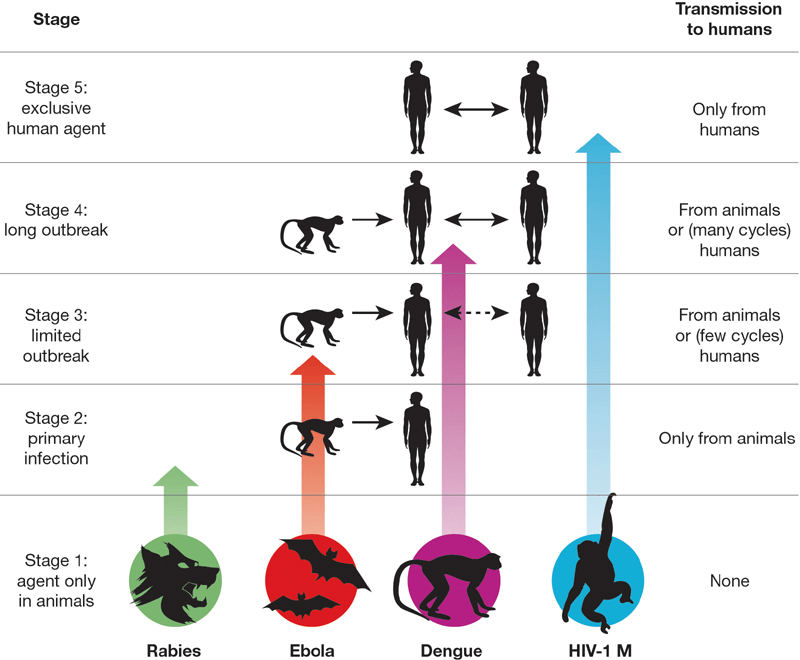Human Infectious Diseases & Viral Pathogen Detection
Infectious diseases often have the characteristics of high risk and public nuisance. In recent years, emerging infectious diseases have an increasing impact on humans. Many infectious diseases, including some that are now limited to humans and animals, have gone through some evolutionary process. The evolution of some human-specific pathogens that originated from animal pathogens has roughly gone through five stages of development, in which a pathogen that infects only animals may transform into a pathogen that infects only humans. The research on the origin of infectious diseases and virus evolution is of great significance for understanding the pathogenesis, control and prevention of infectious diseases. Our RNA visualization solutions help researchers visualize and localize virus-derived RNA in samples and further understand and analyze virus evolution, expression in host cells, and damage to host cells.
 Fig 1. Illustration of the five stages through which pathogens of animals evolve to cause diseases confined to humans. (Wolfe N D, et al. 2007)
Fig 1. Illustration of the five stages through which pathogens of animals evolve to cause diseases confined to humans. (Wolfe N D, et al. 2007)
Viral Pathogen Detection and Visualization Services
RNA in situ hybridization with fluorescently labeled probes can directly detect viral RNA in host cells (human or other animals), helping researchers to quickly determine the etiology and pathogenesis of viral diseases. Our platform undergoes continuous testing, resulting in an in-house optimized analytical test solution (nucleic acid-based molecular detection method). The core of our visual analysis solution is the selection and customization of probes, and virus detection has been greatly improved in terms of sensitivity, specificity, and speed through high-quality molecular probe tools, providing some basic advantages. Molecular detection protocols provided by our platform enable the visualization of viruses in different infected tissues and cell types based on morphological background. We provide the design and customization of many types of molecular probes, and our experts will tailor a personalized solution for you.
Prevalence Panel of Infectious Disease-related Virus Species
We can provide analytical tests for more than 30 human infectious disease-related pathogens, such as COVID-19 coronavirus, Dengue virus, Enterovirus, Hepacivirus, Human betacoronavirus, Human bocavirus, Human coronavirus, Human coxsackievirus, Human endogenous retrovirus, Human herpesvirus, Human immunodeficiency virus 1. Existing commercial probes can be selected for our virus analysis solutions, and we also provide design services for customized custom probe solutions.
Advantages of Molecular Probe-Based RNA Visualization Solutions
In situ visualization provides accurate molecular detection and visualization of host cell types and tissues, helping to elucidate viral transmission, pathogen-host interactions, and more;
Single RNA molecule detection technology and in situ hybridization technology can routinely identify single virus particles in infected cells, improving sensitivity (even early detection of reinfection);
Specific probe design solutions can meet the needs of accurate detection in highly related virus species/strains;
Possibility to detect multiple viruses or to confirm co-infection through different probe combination test protocols (dual and multiplex detection);
 Fig 2. FISH detection of pathogens associated with zoonotic diseases.
Fig 2. FISH detection of pathogens associated with zoonotic diseases.
Creative Bioarray provides a comprehensive RNA visualization analysis solution for genetic analysis of human infectious disease-associated virus evolution and host cell infection mechanisms. Through the use of specific fluorescently labeled probes, it helps researchers to achieve rapid analysis needs. If you are interested in our service, please contact us for cooperation. We look forward to cooperating with you in the near future.
Reference
- Wolfe N D, Dunavan C P, Diamond J. Origins of major human infectious diseases[J]. Nature, 2007, 447(7142): 279-283.


 Fig 1. Illustration of the five stages through which pathogens of animals evolve to cause diseases confined to humans. (Wolfe N D, et al. 2007)
Fig 1. Illustration of the five stages through which pathogens of animals evolve to cause diseases confined to humans. (Wolfe N D, et al. 2007) Fig 2. FISH detection of pathogens associated with zoonotic diseases.
Fig 2. FISH detection of pathogens associated with zoonotic diseases.


